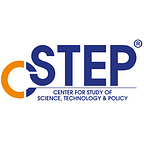Battling COVID-19 With a Multi-disciplinary Integrative Approach
By Jai Asundi, Interim ED, Center for Study of Science, Technology and Policy.
As each of us struggles with the consequences of the COVID-19 pandemic, especially the millions who have lost their livelihoods, our predominant emotion is fear. Fear for what might be — for our health, jobs, families, and looming shortages in our daily lives. As concerned citizens, we wonder if our nation could have responded better to this crisis of many dimensions. What kind of systems should we have/had in place to address a pandemic of such epic proportions?
Researchers and organisations are presenting their modelling studies with predictions on how the disease might spread, expected fatalities and days/weeks our society needs to be locked down. Given the uncertainties in each of these models, which one(s) do we believe? How should the administration treat the recommendations? The government is in the unenviable position of ‘Damned if you do, damned if you don’t’. A famous (modified) quote attributed to British statistician George Box, “All models are wrong, but some are useful” is apropos for our current situation. The challenge lies in identifying the useful models.
A complex system
At the outset, we need to acknowledge that the system we are dealing with is incredibly complex. By definition, a complex system is one where there are a large number of independent interacting components; the system behaviour cannot be explained by an individual component; which evolves along multiple pathways; and which is difficult to understand and verify (by design or function or both) [see Science,1999, Vol. 284, №5411].
Thus, the current emergency needs to be examined at multiple levels. The interaction between these levels clearly suggests that a multi-disciplinary approach is necessary.
As seen in the image below, the situation response can be thought of as three concentric circles. The innermost circle represents the basic understanding of the virology and the spread of disease for the specific virus (COVID-19 in this case), its mechanism for survival and transmission. This subject requires active insights from microbiologists and virologists. Perspectives will need to be updated regularly as the infection spreads, and as we test, with a high degree of certainty, a greater fraction of the population–thus offering new insights over time.
The next circle is the local environment context, where the virus is spreading. This includes the weather, topography, population density, social structure, people movement, local economic factors including manufacturing, services and production of food items including essential items. All these play an important part in the spread/control of the virus. Those that study viral disease vectors and its transmission in the community will need detailed spatio-temporal information to help map the spread of the infection. Simultaneously, social scientists and economists can use the data to estimate the impact on the society as well as economy.
Finally, we have the response context — where we capture the availability of assets like healthcare facilities, shelters, ventilators, personal protective equipment, medicines, disinfection programmes, testing and law enforcement — to address the containment/elimination of the virus. In addition, we capture the supply chains for essential goods and services and other local response measures. Here, civil society can provide vital information and be an invaluable asset.
In each of the levels there will be multiple models, with their own unique assumptions, that will feed into each other. They need to be kept current to account for new information and explicit about the various uncertainties that are typical of any modelling exercise. Also, sophisticated methods and techniques will be needed, to collect/collate the large amounts of spatio-temporal data needed to run the models.
Scenario-based approach
It is clear that we need to take a scenario-based approach to examine the implications of various policy actions — on the spread of the infection, and the wider economy. For instance, the actions to contain an infection are likely to cause a devastating effect on the local economy. The containment measures and distribution of essentials themselves could lead to migration effects or unintended crowding — both of which we have witnessed. We must consider the following questions: How will a lockdown affect a population? What supply chains need to be in place to take care of essential goods and services? What are the second-order effects of a policy measure? How would a partial lockdown impact the spread of infection?
In the past, the collection of social data and integration of various models was a computationally difficult task. Given the new hardware and software platforms available, it is not inconceivable to build such a system to provide valuable inputs to our policymakers, on the choices they are being forced to make with very little real data or information. Such systems will hopefully provide comprehensive solutions, taking all factors — such as impact on infection spread, economy, livelihoods and social structures — into account. Arizona State University’s Decision Theatre is an example of such a system where they help coordinate disaster aid in megacities. Shanghai city also has a system to address their threat from typhoons. While these systems are primarily for physical disasters, they help smoothen supply-chains for essential goods and services, given the constraints of the situation.
We see an urgent need for such integrated decision-support systems for now and the future, to address every conceivable emergency. It is time we built such a system in India to deal with our emergencies. With ingenuity and foresight, we can replace fear with hope and confidence.
The author is Interim Executive Director at the Center for Study of Science, Technology and Policy, Bengaluru (@CSTEP_India), one of India’s leading research-based think tanks.
Contact: Jai Asundi (asundi@cstep.in, Twitter: @JaiAsundi)
